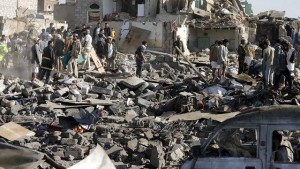 The recent surge in U.S. arms transfers to the Middle East is part of an unprecedented boom in major U.S. arms sales that has been presided over by the Obama administration.
The recent surge in U.S. arms transfers to the Middle East is part of an unprecedented boom in major U.S. arms sales that has been presided over by the Obama administration.
The majority of the Obama administration’s major arms sales have gone to the Middle East and Persian Gulf, with Saudi Arabia topping the list with over $49 billion in new agreements. This is particularly troubling given the complex array of conflicts raging throughout the region, and given the Saudi regime’s use of U.S.-supplied weaponry in its military intervention in Yemen.
The Obama administration has made arms sales a central tool of its foreign policy, in part as a way of exerting military influence without having to put “boots on the ground” in large numbers, as the Bush administration did in Iraq—with disastrous consequences.
___________________________________________________________
The Obama administration has made arms sales a central tool of its foreign policy
___________________________________________________________
The Obama administration’s push for more Mideast arms sales has been a bonanza for U.S. weapons contractors, who have made increased exports a primary goal as Pentagon spending levels off. Not only do foreign sales boost company profits, but they also help keep open production lines that would otherwise have to close due to declining orders from the Pentagon.
For example, earlier this year it was reported that Boeing had concluded a deal to sell 40 F-18s to Kuwait, which will extend the life of the program for another year or more beyond its current projected end date of early 2017. Similarly, the General Dynamics M-1 tank has been surviving on a combination of Congressional add-ons and a deal for tanks and tank upgrades for Saudi Arabia.
But it’s not just about money. U.S.-supplied arms are fueling conflict in the region. The most troubling recent sales is a deal in the works that would supply $1 billion or more in bombs and missiles for the Saudi Air Force, again for use in the Yemen war.
The use of U.S.-supplied helicopters, combat aircraft, bombs, and missiles in Yemen has contributed to the humanitarian catastrophe there. A recent attack on a wedding party that killed more than 130 people is just the latest example of the indiscriminate bombing that has resulted in the majority of the more than 2,300 civilian deaths caused by the war.
The bombing has been coupled with a naval blockade that has led to a situation in which four out of five people in Yemen are now in need of humanitarian aid. An estimated 12.9 million people in Yemen are considered food insecure, and more than 1.2 million children are suffering from moderate to acute malnutrition and half a million are severely malnourished, according to the United Nations World Food Programme. There is a risk of mass starvation if the conflict is allowed to proceed on its current course.
Evidence gathered by Human Rights Watch and Amnesty International indicates that this includes the use of U.S.-supplied cluster bombs in Yemen.
___________________________________________________________
Evidence indicates the use of U.S.-supplied cluster bombs in Yemen.
___________________________________________________________
Cluster bombs are indiscriminate weapons that are the subject of an international treaty banning their use—a treaty that unfortunately has not been signed up to by either the United States or Saudi Arabia.
Things have gotten so out of hand that it is quite possible that U.S.-supplied arms have made their way into the hands of all parties to the conflict in Yemen. As indicated above, U.S. arms are being used by Saudi Arabian and Kuwaiti ground and air forces that are intervening in Yemen, and some weapons may have been lost to either the Houthis or al-Qaeda in the Arabian Peninsula.
The Yemeni military has split down the middle, with forces loyal to former Yemeni president Saleh making common cause with the Houthis while others have taken the side of the Saudis and former President Hadi. Both factions have been on the receiving end of U.S. arms transfers and military training in recent years. Statistics gathered by the Security Assistance Monitor indicate that Yemeni forces received or have been offered over $900 million in U.S. military and police aid since 2009.
Concern about the U.S. role in facilitating the Saudi bombing campaign is growing. Oxfam America has called on the United States to “withdraw its support to the [Saudi-led] coalition including the transfer of arms to belligerent parties, publicly demand the free flow of commercial goods into all ports, and rally support at the United Nations Security Council for an immediate, unconditional cease-fire and inclusive political process to bring an end to the war.”
Sen. Patrick Leahy (D-VT) has raised questions as to what U.S. responsibility may be for Saudi actions, and whether the bombings violate the U.S law that bears his name. The Leahy Law “prohibits the United States from providing assistance to any foreign military or police unit if there is credible information that such unit has committed grave human rights violations with impunity.”
And a letter to President Obama organized by Representatives Debbie Dingell (D-MI), Keith Ellison (D-MN), and Ted Lieu (D-CA) urged the president to make “greater efforts to avoid civilian casualties in Yemen and achieve a diplomatic solution to the conflict.”
The U.S.-backed, Saudi-led intervention in Yemen needs to stop. Stopping U.S. military support for the Saudi effort is a good place to start.
William D. Hartung is the director of the Arms and Security Project the Center for International Policy and a senior adviser to the Security Assistance Monitor. He is a columnist for the CIP Americas Program www.americas.org



